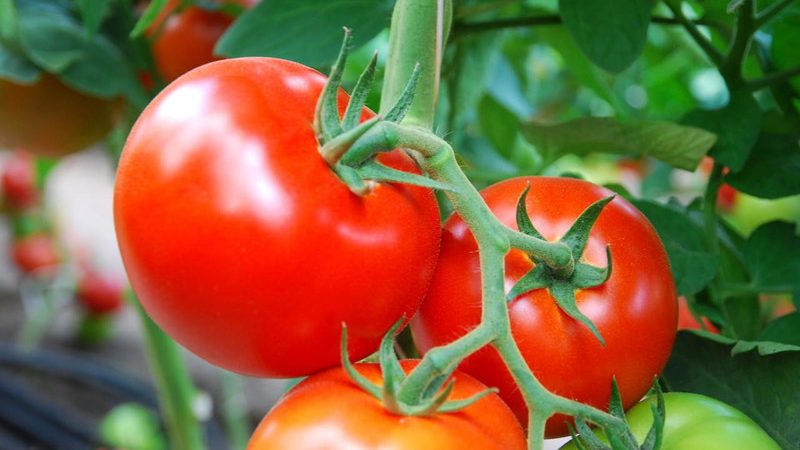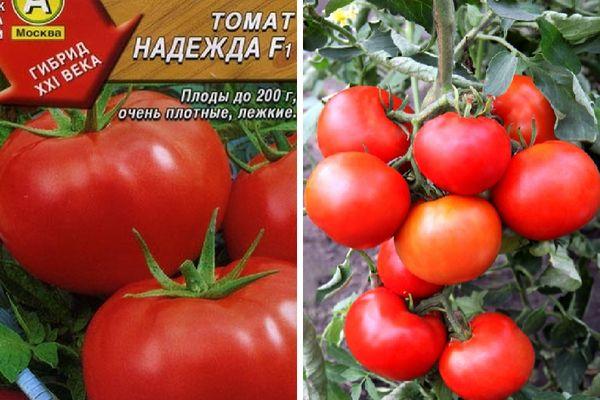How to grow a tomato "Hope f1": lying, early maturing and pleasing with a rich harvest
Tomato Nadezhda F1 was created by domestic breeders. It is intended for growing in the northern regions and central Russia, therefore, it is loved by vegetable growers for its quick adaptation to weather conditions, early and high yield.
The fruits are distinguished by their juicy taste, small flat-rounded fruit size, long shelf life and resistance to heat treatment.
The content of the article
Description of culture
Tomatoes Nadezhda F1 - early ripe hybrid in the first generation... Bushes of the determinant type, that is, they have limited growth, reach a height of 60–75 cm in open ground and 150 cm in greenhouse conditions.
The stems of the bush are dense, light green, the leaves are dark green, of medium size, the inflorescences are of the intermediate type. The bush is spreading and reaches a width of 50-60 cm. You can see the fruits of the hybrid in the photo.

Distinctive features
Hybrid Nadezhda has positive characteristics that allow even novice gardeners to start growing it:
- resistant to both slight negative temperatures and drought with heat;
- early fruiting;
- does not require special feeding and care;
- resistant to disease;
- gives a bountiful harvest.
Fruit characteristics
Hybrid tomatoes Nadezhda are versatile in use. They are used both fresh and after heat treatment. The average weight of one fruit is 70–90 g when grown in open ground, up to 150–200 g in greenhouses.
The peel of the fruit is dense, glossy, a ripe tomato has a bright red color. The pulp is dense, juicy, with a small amount of seeds, has a rich and sweet taste.
Yield
The fruits ripen quickly, in the absence of frost, rain or drought, the first harvest is harvested within 95-100 days after germination. With proper agrotechnology at a summer cottage, up to 5–6 kg are harvested from 1 m2 of plantings, in fields from 1 hectare, values reach 100–120 tons.
The first third of the fruits ripens in the second decade of June. Fruiting lasts until about mid-August, the rest of the crop is harvested as it ripens.
How to grow seedlings
When growing Nadezhda F1 tomatoes through seedlings, the crop can be obtained two weeks earlier than when planting in open ground.
Seed preparation
The seeds of the hybrid are sold ready-made, therefore they are sown dry and do not require special treatment with growth stimulants or bactericidal solutions. Sowing is done in March - early April.
Attention! Seeds should be purchased every year, because when self-collecting planting material from the previous harvest, there is no guarantee that the parental traits will be preserved, a plant with other properties may grow.
Capacity and soil
Special cassettes, boxes or peat tablets and cups with drainage holes are used for planting. The soil is purchased ready-made or prepared independently. The soil should contain peat, turf, humus and sawdust in equal proportions.
For disinfection, before planting seeds, the earth is poured with boiling water or ignited in the oven.
Sowing

The container is filled with a soil mixture 3-4 cm below the edge, the soil is moistened, covered with a film and left under it for a day to distribute moisture evenly.Then small holes are made in the soil into which the planting material is placed. The planted seeds are covered with earth and watered. Cover the container with foil until the first shoots appear. The air temperature is maintained at a level not lower than +25 ° С.
Growing and care
As a rule, the first shoots appear 7-10 days after sowing the seeds. After the emergence of sprouts, within a week, it is necessary to maintain a temperature regime of +15 ° С, then keep the daytime temperature up to +24 ° С, and at night - up to + 12 ° С.
After 10 days, the first feeding is done, after a two-week break, fertilizers are applied again.
So that planting in a permanent place does not become a strong stress for tomatoes, they must be hardened. Seedlings are taken out into fresh air (at a temperature of at least +12 ° C), starting from half an hour and gradually increasing the time.
How to grow tomatoes
Agrotechnics of the Nadezhda hybrid consists of standard procedures for growing other tomatoes.
Landing
Seedlings are placed in a permanent growing place at 60–65 days of the life of the bush. Planting time depends not only on the age of the tomatoes, but also on the degree of warming up of the soil. Before planting, seedlings are fertilized with a complex solution.
Landing technology:
- at a distance of at least 60 cm, dig holes 15–20 cm deep;
- a seedling with an earthen lump is freed from the seedling container and placed in the hole;
- the roots are densely covered with earth until a small embankment is formed on the surface;
- the bush is watered abundantly with warm water;
- the seedling is mulched with ash, sawdust or film.
Reference. The optimal time for planting in the ground is from late May to early June, in the greenhouse - late April.
Care
To get a large harvest of tomatoes, it is necessary to care for the plants in accordance with the rules of agricultural technology, which include:
- watering 1-2 times a week as the top soil layer dries up;
- regular weeding and loosening of the soil;
- hilling bushes 2-3 times per season;
- bush formation (only one main stem is left), pinching;
- garter bush as the plant grows when it reaches a height of 40 cm;
- monthly feeding with potash and phosphorus fertilizers, cow or bird droppings.
Important! Do not use fertilizers with a high nitrogen content. Its excess leads to the growth of extra stems and leaves, which block the formation of the fruit ovary.
Features of cultivation and possible difficulties
Tomato Nadezhda F1 is considered an unpretentious crop, however, it requires constant care and adherence to the correct growing conditions. This will allow achieving high yields and the best taste of the fruit.
When watering, avoid getting water on the leaves... It is important to monitor sufficient soil moisture during the period of ovary formation, otherwise the fruits may grow savory and small.
With an excess of weeds or rapid evaporation of moisture, they resort to mulching - they cover the ground around the plants with organic material, for example, fallen leaves, grass, sawdust or straw.

Diseases and pests
The risk of a hybrid disease with proper agricultural technology is minimal, therefore, spraying with chemicals is used less often than in relation to other nightshades. For the prevention of diseases such as fusarium, late blight, verticillosis, before planting spill the soil with a solution copper sulfate.
Pests such as slugs aphid, Colorado beetles and thrips, most often appear in open beds. To combat them, various insecticides or spraying with an aqueous solution of hydrogen peroxide are used. Large insects and larvae are collected by hand.
The nuances of growing in open ground and in a greenhouse
When choosing a landing site, you must remember the difference and subtleties in care.
Outdoors:
- seedlings are planted only in warm soil;
- in the first few weeks after planting, the bushes are covered with a film to avoid hypothermia;
- independent watering alternate with natural precipitation;
- if the level of precipitation is high, the plants are covered so that the soil does not become waterlogged;
- for garters bushes use stakes;
- the risk of developing diseases and the appearance of harmful insects is higher, therefore the plants are treated with chemicals.
In the greenhouse:
- seedlings are planted 1–1.5 months earlier;
- systematically ventilate the greenhouse so that excess moisture does not accumulate;
- the formation of a bush is more often produced, since it grows more spreading and taller than in open space.
Harvesting and application of the crop
The first harvest should be expected 90 days after planting the seedlings. Fruits are harvested as they ripen. Their weight varies from 80 to 200 g. Until mid-August, all tomatoes are removed, regardless of the degree of maturity, since the life cycle of the bush by this time ends, the leaves turn yellow and begin to die off.
Ripe tomatoes have a short shelf life, so they are eaten immediately or used for preparation. Green fruits or blanche ripeness are harvested for long-term storage or further transportation. Used for making salads, sauces, tomato juice.
Tomatoes Nadezhda f1 are suitable for both private and industrial cultivation.
reference... Early ripeness is best stored in wooden boxes lined with straw or heat-insulating material. Each fruit is wrapped in paper. The box is stored in the cellar or on a warm loggia, covered from excess light.
Advantages and disadvantages of the variety
The Nadezhda F1 hybrid has many advantages. Gardeners note among the main ones:
- resistance to temperature extremes;
- presentation and taste of ripe fruits;
- high productivity;
- long shelf life (1.5–2 months);
- compactness of the bush, which allows you to save space and get the maximum yield per square meter of planting;
- immunity to infectious and fungal diseases characteristic of nightshades.
The disadvantages include:
- the need for regular feeding and watering;
- systematic pinching for maximum yield;
- exactingness of tomatoes for looseness and nutritional value of the soil;
- the need for a garter;
- inability to obtain planting material on your own.
Lake of Hope
Tomato Nadezhda F1 should not be confused with the younger hybrid namesake Lake of Hope, which was created by the breeder L. Myazina.
Lake of Hope is higher, it has few leaves and they are much more massive, the weight of the fruit is 250-300 g, while the fruit on one bush is less than that of Nadezhda F1. When purchasing planting material, you should pay special attention to the characteristics so as not to confuse these two hybrids.
Farmers reviews
The gardeners who grew the hybrid Nadezhda F1 on their plots mainly note its high yield.
Irina Ivanovna, Voronezh: “I am an experienced gardener, I have tried many varieties of tomatoes, but did not get the desired results. Two years ago, a friend advised Nadezhda F1, which won me over. Tomatoes grow well even in the garden, the bushes bore fruit all as one, and there was so much harvest that I did not have time to roll it up and distributed a sack of tomatoes to all relatives. "
Nadezhda Nikolaevna, Tver: “I planted this variety last year. To save time, I bought ready-made seedlings, but I was very worried about how they would take root. Almost all the bushes survived, although I only went to the dacha on weekends. I ate tomatoes all summer and made preparations for the winter. The fruits are juicy, beautiful and tasty. "
Vera, St. Petersburg: “I was very lucky to have stumbled upon this hybrid. In our latitude and weather, it is very difficult to grow something, let alone a good harvest. But the tomato Nadezhda F1 turned out to be so tenacious and strong that my whole family had fresh vegetables to the table in the summer. My husband said that now it is possible to put up a second greenhouse with such a crop! "
Conclusion
Tomato Nadezhda F1 is one of the best early-maturing hybrids.Differs in high yield, resistance to adverse weather conditions, due to which it is suitable even for novice gardeners. Even the exactingness of a hybrid to fertilized and loose soil does not diminish many of its positive qualities.
The long shelf life of the fruit - up to several months - also allows it to be a worthy decoration on the shelves of stores and markets.